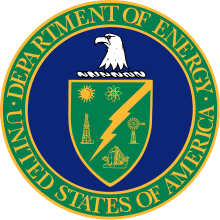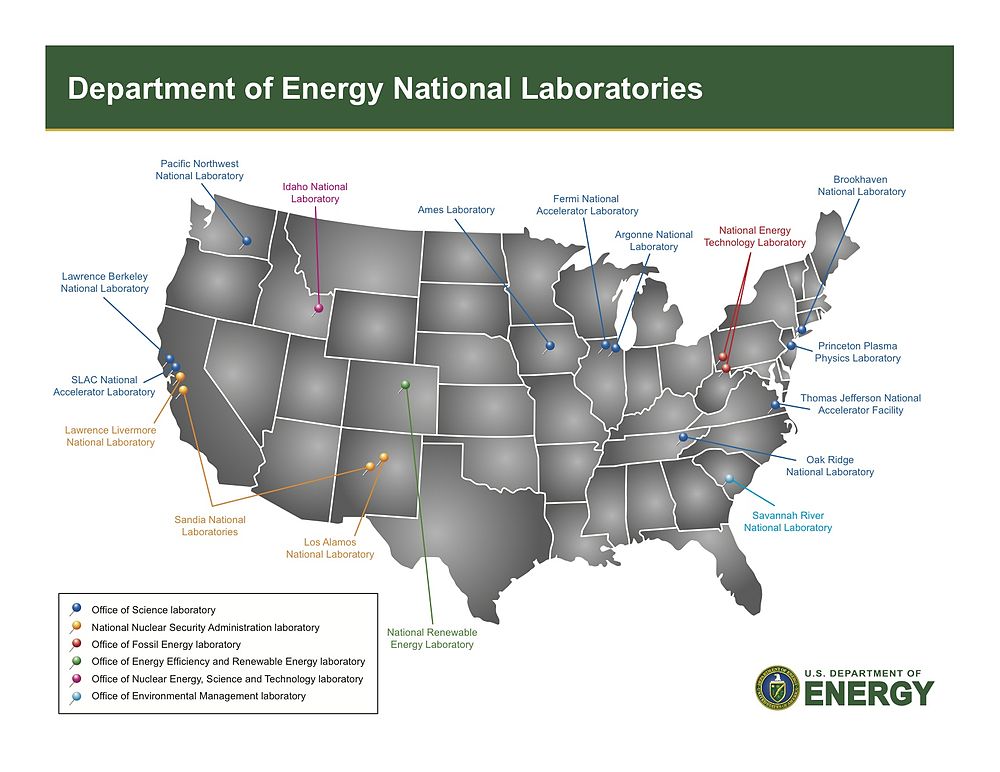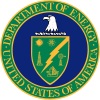- United States Department of Energy National Laboratories
-
The United States Department of Energy National Laboratories and Technology Centers are a system of facilities and laboratories overseen by the United States Department of Energy (DOE) for the purpose of advancing science and helping promote the economic and defensive national interests of the United States of America. Most of the DOE national laboratories are actually federally funded research and development centers administered, managed, operated and staffed by private corporations and academic universities under contract to DOE. The 2005 NASA Authorization Act designated the U.S. segment of the International Space Station as a national laboratory with a goal to increase the utilization of the ISS by other Federal entities and the private sector.
Contents
History
The system of centralized national laboratories grew out of the massive scientific endeavors of World War II, in which new technologies such as radar, the computer, the proximity fuze, and the atomic bomb proved decisive for the Allied victory. Though the United States government had begun seriously investing in scientific research for national security since World War I, it was only in late 1930s and 1940s that monumental amounts of resources were committed or coordinated to wartime scientific problems, under the auspices first of the National Defense Research Committee, and later the Office of Scientific Research and Development, organized and administered by the MIT engineer Vannevar Bush.
During the second world war, centralized sites such as the Radiation Laboratory at MIT and Ernest O. Lawrence's laboratory at the University of California, Berkeley allowed for a large number of expert scientists to collaborate towards defined goals as never before, and with virtually unlimited government resources at their disposal.
In the course of the war, the Allied nuclear effort, the Manhattan Project, created several secret sites for the purpose of bomb research and material development, including a laboratory in the desert of New Mexico directed by Robert Oppenheimer (Los Alamos), and sites at Hanford, Washington and Oak Ridge, Tennessee. Hanford and Oak Ridge were administered by private companies, and Los Alamos was administered by a public university (the University of California). Additional success was had at the University of Chicago in reactor research, leading to the creation of Argonne National Laboratory outside Chicago, and at other academic institutions spread across the country.
After the war and its scientific successes, the newly created Atomic Energy Commission took over the future of the wartime laboratories, extending their lives indefinitely (they were originally thought of as temporary creations). Funding and infrastructure were secured to sponsor other "national laboratories" for both classified and basic research, especially in physics. Each national laboratory would generally be centered around one or many expensive machines (such as particle accelerators or nuclear reactors).
Most national laboratories maintained staffs of local researchers as well as allowing for visiting researchers to use their equipment, though priority to local or visiting researchers often varied from lab to lab. With their centralization of resources (both monetary and intellectual), the national labs serve as an exemplar for Big Science.
Elements of both competition and cooperation were encouraged in the laboratories. Often two laboratories with similar missions were created (such as Lawrence Livermore which was designed to compete with Los Alamos) with the hope that competition over funding would create a culture of high quality work. Laboratories which did not have overlapping missions would cooperate with each other (for example, Lawrence Livermore would cooperate with the Lawrence Berkeley Laboratory, which itself was often in competition with Brookhaven National Laboratory).
The national laboratory system, administered first by the Atomic Energy Commission, then the Energy Research and Development Administration, and currently the Department of Energy, is one of the largest (if not the largest) scientific research systems in the world. The DOE provides more than 40% of the total national funding for physics, chemistry, materials science, and other areas of the physical sciences. Many are locally managed by private companies, while other are managed by academic universities, and as a system they form one of the overarching and far-reaching components in what is known as the "iron triangle" of military, academia, and industry.
List of DOE National Laboratories and Technology Centers
National Laboratories
The United States Department of Energy currently operates 16 national laboratories:
- Lawrence Berkeley National Laboratory* at Berkeley, California (1931)
- Los Alamos National Laboratory* at Los Alamos, New Mexico (1943)
- Oak Ridge National Laboratory* at Oak Ridge, Tennessee (1943)
- Argonne National Laboratory* at DuPage County, Illinois (1946)
- Ames Laboratory* at Ames, Iowa (1947)
- Brookhaven National Laboratory* at Upton, New York (1947)
- Sandia National Laboratories* at Albuquerque, New Mexico and Livermore, California (1948)
- Idaho National Laboratory* between Arco and Idaho Falls, Idaho (1949)
- Princeton Plasma Physics Laboratory* at Princeton, New Jersey (1951)
- Lawrence Livermore National Laboratory* at Livermore, California (1952)
- Savannah River National Laboratory* at Aiken, South Carolina (1952)
- SLAC National Accelerator Laboratory* at Menlo Park, California (1962)
- Pacific Northwest National Laboratory* at Richland, Washington (1965)
- Fermi National Accelerator Laboratory* at Batavia, Illinois (1967)
- National Renewable Energy Laboratory* at Golden, Colorado (1977)
- Thomas Jefferson National Accelerator Facility* at Newport News, Virginia (1984)
- National Energy Technology Laboratory** at Albany, Oregon; Fairbanks, Alaska; Morgantown, West Virginia; Pittsburgh, Pennsylvania; and Sugar Land, Texas (1999)
Technology Centers
- New Brunswick Laboratory**, at Argonne National Laboratory
- Oak Ridge Institute for Science and Education* at Oak Ridge, Tennessee
- Radiological and Environmental Sciences Laboratory**
- Savannah River Ecology Laboratory*
* GOCO (Government-owned, Contractor-operated)
** GOGO (Government-owned, Government-operated)List of scientific user facilities
- Accelerator Test Facility
- Advanced Light Source
- Advanced Photon Source
- Alcator C-Mod
- Argonne Tandem Linear Accelerator System
- Atmospheric Radiation Measurement
- B-Factory
- Bates Linear Accelerator Center
- Booster Neutrino
- Center for Functional Nanomaterials
- Center for Integrated Nanotechnologies
- Center for Microanalysis of Materials
- Center for Nanophase Materials Sciences
- Center for Nanoscale Materials
- Combustion Research Facility
- Continuous Electron Beam Accelerator Facility
- DIII-D Tokamak Facility
- Electron Microscopy Center for Materials Research
- Energy Sciences Network
- Environmental Molecular Sciences Laboratory
- Final Focus Test Beam
- Free Air CO2 Experiment
- High Flux Isotope Reactor Center for Neutron Scattering
- Holifield Radioactive Ion Beam Facility
- Intense Pulsed Neutron Source
- James R. Macdonald Laboratory
- Joint Genome Institute
- Linac Coherent Light Source
- Main Injector
- Los Alamos Neutron Science Center
- Manuel Lujan Jr. Neutron Scattering Center
- Materials Preparation Center
- Molecular Foundry
- National Center for Electron Microscopy
- National High Magnetic Field Laboratory
- National Energy Research Scientific Computing Center
- National Ignition Facility
- National Spherical Torus Experiment
- National Synchrotron Light Source
- Next Linear Collider Test Accelerator
- Neutrinos at the Main Injector
- Notre Dame Radiation Laboratory
- Pulse Radiolysis Facility
- Radiochemical Engineering Development Center
- Relativistic Heavy Ion Collider
- Shared Research Equipment Program
- Spallation Neutron Source
- Stanford Synchrotron Radiation Laboratory
- Structural Biology Center
- Synchrotron Radiation Center
- Tevatron collider
- Texas A&M Cyclotron Institute
- Triangle Universities Nuclear Laboratory
- University of Washington Tandem Van de Graaff
- Yale University Tandem Van de Graaff
Further reading
- Westwick, Peter J. The National Labs: Science in an American System, 1947–1974. Cambridge: Harvard University Press, 2003.
External links
Independent agencies Agriculture Commerce Defense Defense Advanced Research Projects Agency (DARPA), Army Research Laboratory (ARL), Naval Research Laboratory (NRL), Office of Naval Research (ONR), Air Force Research Laboratory (AFRL), Coast Guard Research & Development Center (CG RDC)Energy Office of Science (DOE SC), Advanced Research Projects Agency-Energy (ARPA-E), National LaboratoriesHealth and Human Services Homeland Security Interior Veterans Affairs Policy-making bodies
Wikimedia Foundation. 2010.



